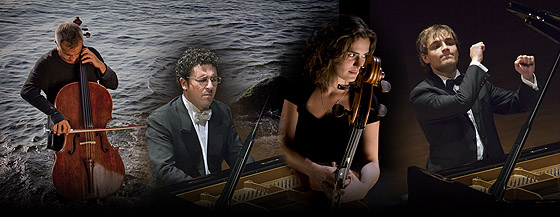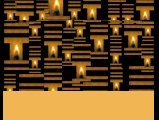
Thursday 17th October 2013
Hong Kong City
Hall Concert Hall - 20:00
 |
 |
 |
 |
 |
 |
 |
 |
 |
 |
Giuseppe ANDALORO (piano), Ilya RASHKOVSKIY (piano),
Giovanni SOLLIMA (cello) & Monika LESKOVAR (cello) |
 |
 |
 |
 |
 |
PROGRAMME
 |
 |
 |
| 1st Part |
| |
| 1. Igor Stravinsky (1882 – 1971) |
| |
 The Rite of Spring The Rite of Spring |
| |
|
(arr. for two pianos and two cellos by Giuseppe Andaloro)
The Rite of Spring (French: Le Sacre du printemps) is a ballet and orchestral concert work by the Russian composer Igor Stravinsky. It was written for the 1913 Paris season of Sergei Diaghilev's Ballets Russes company; the original choreography was by Vaslav Nijinsky, with stage designs and costumes by Nicholas Roerich. When the ballet was first performed, at the Théâtre des Champs-É lysées on 29 May 1913, the avant-garde nature of the music and choreography caused a sensation and a near-riot in the audience. Although designed as a work for the stage, with specific passages accompanying characters and action, the music achieved equal if not greater recognition as a concert piece, and is widely considered as one of the most influential musical works of the 20th century.
In the scenario, after various primitive rituals celebrating the advent of spring, a young girl is chosen as a sacrificial victim and dances herself to death.
Stravinsky's score contains many features that were novel for its time, including experiments in tonality, metre, rhythm, stress and dissonance. Analysts have noted in the score a significant grounding in Russian folk music, a relationship which Stravinsky tended to deny. The music has influenced many of the 20th century's leading composers and is one of the most recorded works in the classical repertoire. |
| |
|
| |
| Part One: |
THE ADORATION OF THE EARTH |
| |
1. Introduction |
| |
2. Augurs of Spring |
| |
3. Ritual of Abduction |
| |
4. Spring Rounds |
| |
5. Ritual of the Rival Tribes |
| |
6. Procession of the Sage |
| |
7. Dance of the Earth |
| |
|
| Part Two: |
THE SACRIFICE |
| |
1. Introduction |
| |
2. Mystic Circles of the Young Girls |
| |
3. Glorification of the Chosen One |
| |
4. Evocation of the Ancestors |
| |
5. Ritual Action of the Ancestors |
| |
6. Sacrificial Dance |
|
|
 INTERMISSION INTERMISSION 
 |
 |
 |
| 2nd Part |
| |
| 2. Witold Lutoslawski (1913 – 1994) (celebrating his 100th birthday anniversary) |
| |
 Paganini variations for two pianos Paganini variations for two pianos |
| |
|
Lutoslawski described musical composition as a search for listeners who think and feel the same way he did – he once called it “fishing for souls”. Lutoslawski began his career as a composer shortly before the Second World War, which disrupted it. During the German occupation of Poland, Polish cultural life went underground. Lutoslawski and his friend Panufnik played piano duets in a Warsaw café, since the Germans had banned public concerts, serious music-making could only be heard in cafes. Included in the repertoire was Lutoslawski’s two piano transcription of Paganini’s Caprice No. 2. W.Lutoslawski said of this piece: “As a basis I took Paganini’s 24th Caprice for solo violin and my Variations closely follow this model. In each Variation I translate the violin line for the keyboard. Polyharmony often occurs between the two keyboards but tonality remains a clear force with frequent traditional dominant-tonic cadences.” |
| |
|
| 3. Claude Debussy (1962 – 1918) |
| |
 Prélude à l’après-midi d’un faune (Prelude to the Afternoon of a Faun) Prélude à l’après-midi d’un faune (Prelude to the Afternoon of a Faun) |
| |
|
(arr. for two cellos by Giovanni Sollima) |
| |
|
“Prélude à l’après-midi d’un faune” is a symphonic poem for orchestra by Claude Debussy. The composition was inspired by the poem “L’après-midi d’un faune”by Stéphane Mallarmé, and later formed the basis for the ballet Afternoon of a Faun, choreographed by Vaslav Nijinsky. About his composition, Debussy wrote: “The music of this prelude is a very free illustration of Mallarmé’s beautiful poem. By no means does it claim to be a synthesis of it. Rather there is a succession of scenes through which pass the desires and dreams of the faun in the heat of the afternoon. Then, tired of pursuing the timorous flight of nymphs and naiads, he succumbs to intoxicating sleep, in which he can finally realize his dreams of possession in universal Nature” |
| |
|
| 4. Maurice Ravel (1875 – 1937) |
| |
 La Valse La Valse |
| |
|
(arr. for two pianos and two cellos by Giuseppe Andaloro) |
| |
|
A choreographic poem for orchestra, it was conceived as a ballet but is now more often heard as a concert work. The work has been described as a tribute to the waltz. Ravel denied that it is a reflection of post-World War I Europe, saying: “While some discover an attempt at parody, indeed caricature, others categorically see a tragic allusion in it – the end of the Second Empire, the situation in Vienna after the war, etc… This dance may seem tragic, like any other emotion … pushed to the extreme. But one should only see in it what the music expresses: an ascending progression of sonority, to which the stage comes along to add light and movement. |
|

 |
 |
 |
 |
 |
 |
 |
 |
 |
 |
安達羅洛 ( ), 蘭殊高夫斯基 ( ), 蘭殊高夫斯基 ( ), ),
索利馬 ( ) 及萊什科瓦爾 ( ) 及萊什科瓦爾 ( ) ) |
 |
 |
 |
 |
 |

  
|


